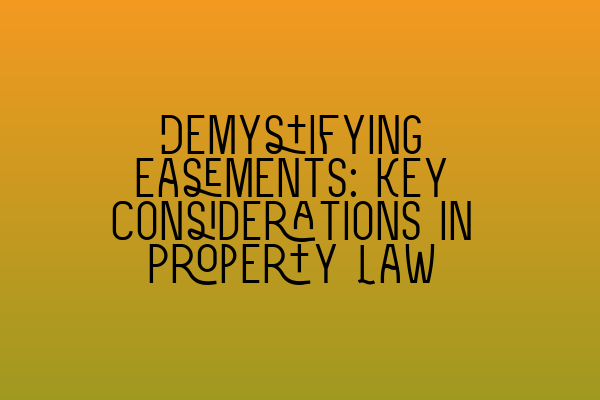Demystifying Easements: Key Considerations in Property Law
Introduction
In the vast world of property law, easements can often be a mystery to many people. With complex legal jargon and intricate concepts, understanding easements can be quite challenging. However, it is essential to have a solid grasp of this area of property law, as easements can significantly impact property rights and transactions. In this blog post, we will demystify easements and provide you with key considerations to navigate this aspect of property law effectively.
What is an Easement?
To put it simply, an easement is a legal right that allows a person or entity to use another person’s property for a specific purpose. This usage can be for activities such as accessing a property, passing over a certain area, or utilizing a shared resource. An easement is typically granted in perpetuity and can be both beneficial and restrictive, depending on the circumstances.
Types of Easements
Easements can be categorized into various types, each with its own set of characteristics and legal implications. Some common types of easements include:
1. Right of way: This type of easement grants the right to pass through another person’s property, often for a specific purpose, such as accessing a public road or neighboring property.
2. Easement by necessity: When a property is landlocked, meaning it has no direct access to a public road, an easement by necessity may be granted to provide access to the property.
3. Easement by prescription: Also known as prescriptive easements, these are easements that arise from continuous and unimpeded use of another person’s property for a specified period. This type of easement is similar to adverse possession, but it only grants the right to use the property, rather than ownership.
4. Easement for utilities: Utility companies often hold easements to install and maintain infrastructure such as power lines, water pipes, and sewer systems on private properties.
Key Considerations in Easements
When dealing with easements in property law, there are several important considerations to keep in mind. These considerations ensure that your rights are protected and that you navigate through any potential challenges smoothly.
1. Documentation and Legal Agreements: It is crucial to have clear and legally binding documentation in place when creating, transferring, or modifying easements. This includes drafting agreements, obtaining consent from relevant parties, and registering the easement with the appropriate authorities. Seeking professional legal advice in these matters can help ensure compliance and avoid any future disputes.
2. Property Surveys and Boundaries: Accurate property surveys are essential when dealing with easements. Understanding the physical boundaries of the easement area and identifying any potential conflicts or encroachments is crucial. Engaging a professional surveyor can help you navigate these complexities and avoid future disputes.
3. Maintenance and Duties: Easements often come with maintenance responsibilities and obligations for both the owner of the property and the party benefiting from the easement. Clearly outlining these responsibilities in the legal agreements is crucial to avoid any misunderstandings or conflicts in the future.
4. Termination and Modification: Easements can be terminated or modified by mutual agreement, abandonment, court order, or through other legal means. Understanding the circumstances and procedures for terminating or modifying an easement is important to ensure compliance with the law and protect your interests.
Conclusion
Easements are an integral part of property law, and understanding their nature and implications is crucial for property owners, developers, and real estate professionals. By demystifying easements and considering key factors such as documentation, property surveys, maintenance responsibilities, and termination procedures, you can navigate through this aspect of property law with confidence.
If you’re looking to further your knowledge in property law or prepare for the SRA’s SQE exams, check out our related articles and courses:
– SQE 1 Practice Exam Questions
– SQE 1 Practice Mocks FLK1 FLK2
– SQE 2 Preparation Courses
– SQE 1 Preparation Courses
– SRA SQE Exam Dates
By staying informed and seeking professional legal guidance, you can navigate easements and property law with confidence and ensure that your property rights and transactions are protected.
